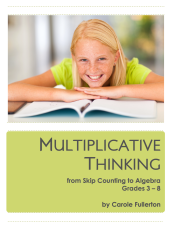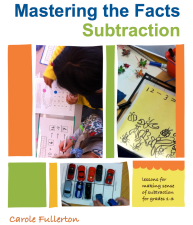Good Questions for Kindergarten & Grade 1
Lessons and Open-ended Tasks for Building Number Sense: A New Resource by Carole Fullerton
Good questions engage students in important mathematics. They inspire and propel students in their learning, offering an entry point for all. What better response could there be for our delightfully diverse early primary classrooms?
This new combined grades resource is built around good questions, drawn from each of the strands in the Kindergarten and Grade 1 curricula. Lessons feature sorting and patterning, shape and measurement and number sense (subitizing, counting, estimating and the operations) in an accessible format for teachers of early primary.
At the end of each set of lesson sequences, a collection of more than 200 open-ended tasks is presented to allow for building, exploration, practice and extension, meeting the needs of all learners.
Have fun! Get inspired! Keep them thinking!
NEW Resource! Proportional Reasoning in Grades 4-8
 For those who have been patiently waiting (and lovingly nagging!) I am happy to announce the publication of my newest math teaching resource: Proportional Reasoning in Intermediate for Grades 4-8, available now through my online store.
For those who have been patiently waiting (and lovingly nagging!) I am happy to announce the publication of my newest math teaching resource: Proportional Reasoning in Intermediate for Grades 4-8, available now through my online store.
This resource for teachers of Grades 4 to 8 presents more than 250 pages of open-ended lessons, meaningful practice, games, literature connections and a wealth of problem-solving contexts for supporting students to make sense of fractions, decimals, percentages, ratios and proportions. Designed for today’s diverse classrooms, this resource offers a range of tasks to promote proportional thinking through intentional development of mathematical language and the use of key manipulatives. Colour tiles, Cuisenaire rods and tangrams are used to model and make connections within and between concepts.
In the first section of the resource, students will explore three models – set, area and linear – for representing and describing, comparing and ordering fractions. Students will learn to convert between fractions, decimals and percent and to apply these skills to problem situations, including measurement, tax, discounts and data management. Next, students learn to add and subtract fractions, to solve proportions using a range of strategies (involving both mental math and the appropriate use of technology) and then finally to multiply and divide fractions.
Assessment tools are threaded throughout the resource to allow teachers to keep track of student progress and to make instructional decisions.
Proportional reasoning IS the math we do every day. This resource provides an access point for all.
Enjoy!
Another New Resource! Multiplicative Thinking – From Skip Counting to Algebra (Grades 3 to 8)
 For those of you about to return to another school year, welcome back!
For those of you about to return to another school year, welcome back!
I am truly excited to announce the release of my newest teacher resource book: Multiplicative Thinking: From Skip Counting to Algebra (Grades 3 to 8). This book is designed for teachers of the intermediate grades and is focused on the teaching and learning of multiplication. This resource addresses multiplication deeply — what it means to multiply, when to use multiplication in problem-solving situations, as well as how to manipulate whole number, fractional and decimal factors using strategies like the distributive property.
Lessons on skip counting, patterns in the multiples, factoring, and on prime and composite numbers are included in this 220 page teacher resource. Algebraic thinking is explored as well, from T-charts and input-output machines to solving equations, from graphing linear relations and extrapolation to finding the slope of a line. Students engage with visuals and real-world problems involving proportionality, rates, discounts and taxes to build their understanding of multiplicative thinking and see its very real application to their everyday lives.
Each of the 40 lessons features a connection to prior knowledge, whole class and small group explorations of the Big Math Ideas, guided conversations about the mathematics with key vocabulary, opportunities for meaningful practice, tasks for consolidation and customized assessment tools. Skill building lessons are interspersed throughout the book, ensuring students recall and continue to practice the essential skills needed to apply multiplicative ideas.
And of course literature links and games for practice are — as always — included!
Multiplicative Thinking: From Skip Counting to Algebra (Grades 3 to 8) is available for $40 + $10 expedited shipping. To order, click here or on the link at the right. From there you can also order other titles, including Mastering the Facts: Multiplication, a resource dedicated to the teaching and mastery of the critically important multiplication facts. It’s a perfect complement to this new volume and one that can be used in advance — or concurrently — to build a solid foundation.
Thank you for your support. All the best for a remarkable school year!
Carole
Why Multiplicative Thinking?
Multiplicative thinking plays an enormous role in elementary and middle school mathematics. So much bigger than simply knowing the facts — a critically important aspect — the ability to think multiplicatively is essential for success with almost every other mathematical concept, from ratio and proportionality to algebra. It is the operation most often used in “real life” to make sense of large quantities, of taxes and discounts, of income per hour and kilometres travelled. It’s the operation we use when we figure out how much paint or carpet to buy or what a tank of gas is going to cost; when we convert currency for a holiday away or sort out how much to tip on a meal. No matter where we look, multiplicative situations abound. We can’t spend too much time on the teaching and learning of these critical concepts!
In writing this resource, I have attempted to introduce multiplicative thinking — both the operation itself and the bigger concept of multiplicative reasoning — in a sense-making way. Through stories, models, pictures and words, students are introduced to the idea of multiplication as “groups of” and as “rows of”. Problems are posed to support learners in connecting what they know about patterns in the multiples to proportional situations. The associative and distributive properties are introduced and applied. Algebraic concepts — input and output machines, graphing and exploring the rate of change in linear relations — round out the topic and provide a preview for multiplicative reasoning at the middle and high-school levels.
Addressing Diversity in Math with Open Ended Questions
 Our math classrooms are more and more diverse each year. Learners come to us with a range of different experiences and levels of understanding of the mathematics that’s important to know. Meeting the needs can prove challenging. Dr. Marian Small’s book called Good Questions: Great Ways to Differentiate Mathematics Instruction is an excellent resource for learning how to craft questions to make the math accessible to all – challenging for those who need it, and simplified for others. Check it out for more rich and open tasks to engage children in thinking mathematically across the grades!
Our math classrooms are more and more diverse each year. Learners come to us with a range of different experiences and levels of understanding of the mathematics that’s important to know. Meeting the needs can prove challenging. Dr. Marian Small’s book called Good Questions: Great Ways to Differentiate Mathematics Instruction is an excellent resource for learning how to craft questions to make the math accessible to all – challenging for those who need it, and simplified for others. Check it out for more rich and open tasks to engage children in thinking mathematically across the grades!
This is an incredibly useful teacher resource book. In it, Dr. Small poses open-ended questions across the strands as well as what she terms “parallel tasks”, which present the same math concept at 2 different levels of complexity. It’s a very clever way to include everyone in the mathematical discussion, and can really help when we’re planning for instruction in a combined grade setting. Oh – and did I mention that Marian Small is Canadian?? 🙂 Her work is in line with the WNCP math curriculum and so makes a great match for anyone teaching math here in Canada.
This selection of questions from Dr. Marian Small’s book are ideal for combined grades settings, since they address big math ideas that are common to side-by-side curricula. Invite your students to represent their thinking with models, pictures and words, and to share what they know with a peer, a small group and/or the class. These questions lend themselves to rich classroom discussions, and can give you as a teacher important assessment data to inform your planning.
Enjoy!
Carole
PS – Marian Small has also authored a companion book for secondary math that’s well worth checking out: MORE Good Questions: Great Ways to Differentiate Secondary Mathematics Instruction.
Open-ended Problems for K-4
Last week I gave a session for teachers in Coquitlam looking to teach – and assess – problem-solving. We talked about what made a good problem, both in terms of content and wording, then worked through some samples across the grades. I have posted a selection of problems for you here, which I invite you to download and use with your students.

Remember that it’s important to collect students’ thinking in a variety of forms – numbers, pictures and words, to have them engage with models or manipulatives, and wherever possible to have students communicate their understandings about a concept by translating them to a problem of their own. The latter is no small task! :o) John Van de Walle’s diagram outlines the importance of not only including these representations but also connecting and bridging between them. Students learn deeply when they transform their learning from numbers to models, from words to pictures, from problems to numbers and back again…
Carole









